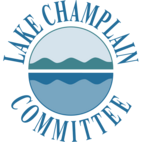Water News from Near and Far
Manure to Energy Plan for St. Albans
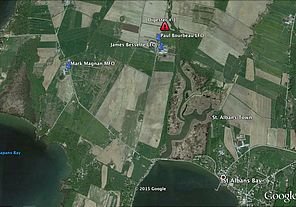
Green Mountain Power has announced plans to build a community manure digester in the St. Albans Bay watershed. Manure digesters capture the methane (natural gas) produced by decomposing cow manure and convert it to electricity. The proposed project would combine manure from three farms in the watershed.
Manure digesters have been around for decades, but widespread adoption has been limited. The first in the Lake Champlain Basin was installed at the Foster Brothers Farm in Middlebury. In 2004, Green Mountain Power began a Cow Power program, and the Audet family’s Blue Spruce Farm in Bridport was the first farm to participate. Digesters however are mechanically complex. They only make sense if there is a large quantity of manure so that energy production is significant, or if the farm happens to have someone available to troubleshoot when things go wrong. The innovative approach with the St. Albans project is the combination of manure from multiple farms.
Digesting reduces the volume of the manure. It extracts any water and promotes decomposition, with the products of decomposition being used for electricity production. The remaining manure can be returned to the farms for use as bedding for their animals.
Manure digesters are a great way to extract additional value from cow manure and we applaud GMP for taking this step, but it is important to remember digesters do not get rid of phosphorus. They do concentrate phosphorus and make it easier to move to other places, but in terms of phosphorus’s impact on the lake, it matters where those other places are.
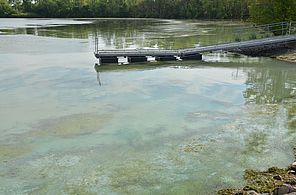
Climate Change Means More Pollution
Researchers from Canada have attempted to model changes in nitrogen and phosphorus loads to Missisquoi Bay likely to result from climate change. They predict a mean annual sediment increase of 1% to 7%, a phosphorus increase of 13% to 20%, and a nitrogen increase of 24% to 43% over the next fifty years. Lead researcher Chanra Madramootoo noted, “If these projected results become a reality, it will be very difficult to achieve the proposed water quality standards set by the governments of Vermont and Quebec”. The research appeared in the Canadian Journal of Social Science.
Pollution Trading Questioned
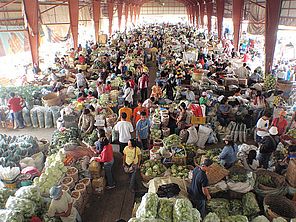
One potential tool for dealing with pollution is to create a market for it, and then reduce the amount available. Ingenuity would then drive pollution control efforts, and those able to produce their product with less pollution would have an overall advantage. This approach, trading of pollution credits, was enormously successful in reducing emissions of acid rain precursors. It has been proposed as “cap-and-trade” as a form of dealing with carbon emissions that drive global warming. And EPA has promoted “water quality trading” programs as a tool to deal with nutrient pollution in lakes and rivers.
A recent review by the advocacy group Food and Water Watch, is highly critical of water quality trading programs. They reviewed over 1,000 documents from programs in Pennsylvania and Ohio and found little state oversight. As a result, highly regulated industries traded pollution credits with lightly regulated farms which then failed to monitor required pollution reductions. Food and Water Watch has previously sued to end trading programs, but the court ruled they did not have standing and the case was dismissed.
Dr. Richard Moore, professor emeritus at Ohio St. University dismissed the report for its omissions and misrepresentations. Dr. Moore was involved with monitoring of one of the trading programs critiqued by Food and Water Watch. He says monitoring showed that streams improved after the trading program was instituted and that should be the most important factor considered.
Trading has been proposed in the Lake Champlain watershed as a possible tool for addressing water quality needs. In 2012, the Vermont Agency of Agriculture received a grant from the federal Department of Agriculture to assess the feasibility of a trading program in our region. However, the final report for that project indicated that some of the conditions necessary to set up a trading network were not present in the Champlain Basin. In particular, the report found there were not enough potential sellers of pollution reduction credits. Every sector already needs to make significant reductions, so there is no excess to be sold.
Bird Die Off on Lake Ontario
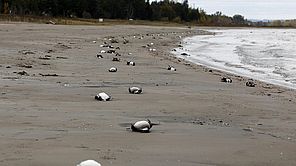
Dead waterfowl and other fish eating birds were washing up on the shores of Lake Ontario according to the Rochester Democrat and Chronicle and other news outlets. Type E avian botulism is the expected cause of the bird deaths. Outbreaks of avian botulism have become common in the region in the last 10 to 15 years. Birds that contract the disease become paralyzed and drown. Loons, gulls, grebes, and fish-eating ducks are the most frequent victims.
There are several different strains of botulism. All are caused by a bacterium that thrives in warm, low-oxygen conditions. The disease is transmitted through food, and causes a loss of muscle control leading to paralysis. Type E, unlike many others, can survive freezing and thus is more common in northern climates.
Avian botulism is exacerbated by invasive species. The bacterium that causes the disease thrives in beds of invasive quagga and zebra mussels. Fish take up the bacterium and are then eaten by birds. In particular, round goby, an invasive species has been implicated in transferring the disease to birds. Gobies can survive for up to 24-hours after contracting the disease, but they swim more slowly and erratically and thus become vulnerable to predation by birds.
A statement released by the New York Department of Environmental Conservation (NYDEC) advised, “Hunters and anglers who harvest normal-acting waterfowl and fish do not need to take any special precautions when handling or consuming their harvest. However, birds or fish exhibiting abnormal activity may be sick and should not be consumed as cooking may not destroy the botulism toxin".
